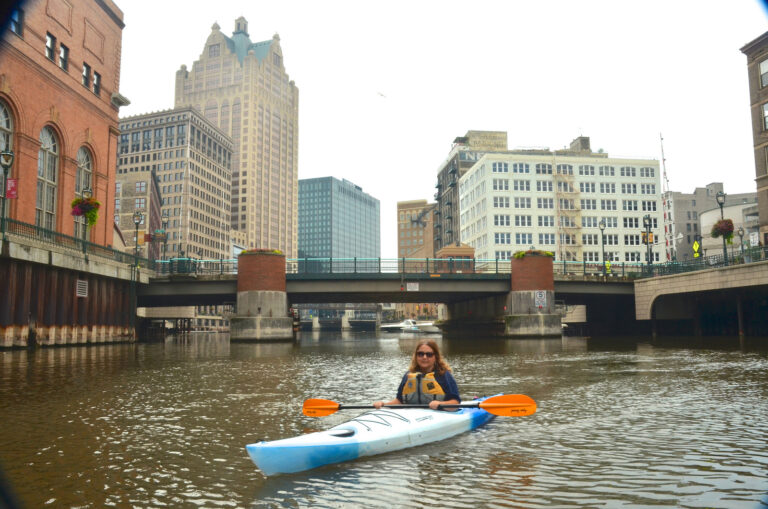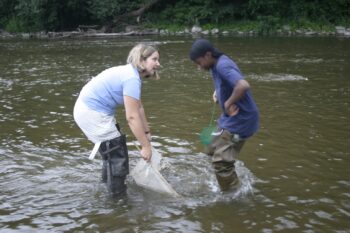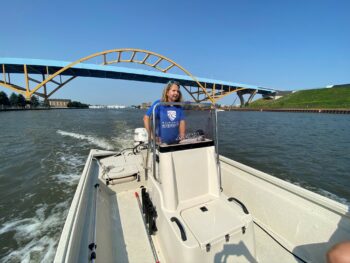Who Is Waterkeeper: Cheryl Nenn, Milwaukee Riverkeeper
By: Thomas Hynes

The city of Milwaukee is home to the confluence of three rivers: the Menomonee River, the Kinnickinnic River, and the aptly named Milwaukee River. The greater watershed, which covers nearly 1,000 square miles across portions of 7 counties, most of which is rural, and home to over a million people.
Like a lot of American cities, Milwaukee suffered through rampant pollution in the years and decades leading up to the Clean Water Act’s passage in 1972. Cleveland may be the poster city for burning rivers, Milwaukee also shares that unfortunate designation. However, the Clean Water Act didn’t solve everything. In 1993, Milwaukee’s water supplies were contaminated with the bacteria Cryptosporidium, which resulted in dozens of deaths, and hundreds of thousands of people becoming sick.
Two years later, in 1995, the Friends of Menomonee Rivers was founded to help turn the tide of local pollution. The organization would go on to become Milwaukee Riverkeeper, which would become one of the founding members of Waterkeeper Alliance in 1999. Cheryl Nenn has been the Milwaukee Riverkeeper since 2003. Prior to this role, Cheryl worked for the city of New York managing natural areas. She also worked for the Peace Corps, consulting on Forest Service projects, as well as for the State of Michigan. She had never worked in the nonprofit space before, but when this job became available she was immediately interested. 
“Being able to work at an organization where I get to protect water quality and wildlife habitat, and advocate for fish and freshwater mussels and critters has been a big privilege and honor. I was hired on a one-year contract twenty years ago. It ended up being a really amazing fit,” says Cheryl. “It’s a multi-faceted job. Some cases you’re a project manager, you’re a scientist, you’re an advocate. There’s a lot of different roles that we play in protecting our waterbodies.”
Lately, the job has her working on educating the public on a major dredging project happening in downtown Milwaukee. When completed, nearly a dozen miles of the river will be relieved of toxic sediments at the cost of roughly $400 million. Getting rid of these toxins is crucial, as they are currently able to easily contaminate the water supply for over a million people.
“This is a generational opportunity to remove this stuff from the bottom of the river where it’s been sitting for a hundred years. Getting it out of the fish, getting it out of the food chain. I mean it’s even in the birds. We have very toxic birds. It’s incredible how this stuff gets into the food chain,” says Cheryl. “That’s why we are working so hard on this. Because it’s important. It sets us up for success in the future.”
One thing Cheryl doesn’t work on as much these days is dam removal, but that’s only because she has worked on so many successful dam removal and fish passage projects already. Milwaukee Riverkeeper has successfully advocated for the removal of nearly a dozen dams and fish passage barriers in the watershed (with many partners), with two more fish passage projects in the works.
 Removing dams is particularly satisfying in how quickly it improves water quality and other conditions for wildlife. Conversely, damming a river is not great for fish. At its worst point, downtown Milwaukee was home to just four species of fish. Today, thanks to dam removal as well as sewage treatment updates and other improvements, aquatic life diversity has increased tenfold, with the area now home to nearly 50 species of fish, not to mention all the other non-finned critters that have also returned. One noteworthy recently returned species is the sturgeon, the hardy fish that serves as the logo for Waterkeeper Alliance.
Removing dams is particularly satisfying in how quickly it improves water quality and other conditions for wildlife. Conversely, damming a river is not great for fish. At its worst point, downtown Milwaukee was home to just four species of fish. Today, thanks to dam removal as well as sewage treatment updates and other improvements, aquatic life diversity has increased tenfold, with the area now home to nearly 50 species of fish, not to mention all the other non-finned critters that have also returned. One noteworthy recently returned species is the sturgeon, the hardy fish that serves as the logo for Waterkeeper Alliance.
Deconcretizing, or removing concrete from the bed and banks of rivers is another priority area, especially on the Kinnickinnic River, which is among the most urbanized rivers in the country. Removing these impermeable surfaces improves flood management, water quality, wildlife habitat, public safety, and overall hydrology. It’s no easy task and many thought Cheryl was foolish for even trying to improve the river.
“When I started here, people told me not to work on the Kinnickinnic. There was so much pollution and flooding. Nobody really thought anything could be done about it, “says Cheryl. “So it’s exciting to see what we have already been able to accomplish as a community.”
When Cheryl isn’t working on these issues, she can be found testing for PFAS and other water quality indicators, advocating for stronger protections, or talking with farmers and landowners about “continuous living cover,” vegetative stream buffers, and other ways to prevent nutrient pollution runoff, or perhaps educating students at Milwaukee Public Schools. But, when she’s not doing all of that, she can often be found paddling on the river. She encourages others to do the same. In fact, in 2006, Nenn helped create the Milwaukee Urban Water Trail so that people could more easily access and enjoy the waterways. That initiative is now designated a National Recreation Trail and one of American Canoe Association’s best trails.
“It’s super fun to expose people to what the city is like from the water,” says Cheryl. “So many people don’t have that opportunity. Especially on a kayak, it gives people a whole new perspective.”
The paddle events with the public work as a great marketing tool for Milwaukee Riverkeeper’s work. But it also underscores the importance of the water based tourism industry in Wisconsin, which Cheryl posits is valued somewhere between $10-12 billion annually.
In addition to all of this local work, Cheryl also serves on the Board for Waterkeeper Alliance. Informally, she has also been an invaluable resource to countless Waterkeeper groups throughout the world.
“I’ve been very privileged to be part of Waterkeeper Alliance, to be mentored by some of the greats, and I’m hoping to do the same for others. I’m probably spending more time mentoring others at this point in my career than I am being mentored,” says Cheryl. “It is very gratifying.”
Cheryl is grateful to be a part of Waterkeeper Alliance. Suffice to say, the feeling is very mutual.